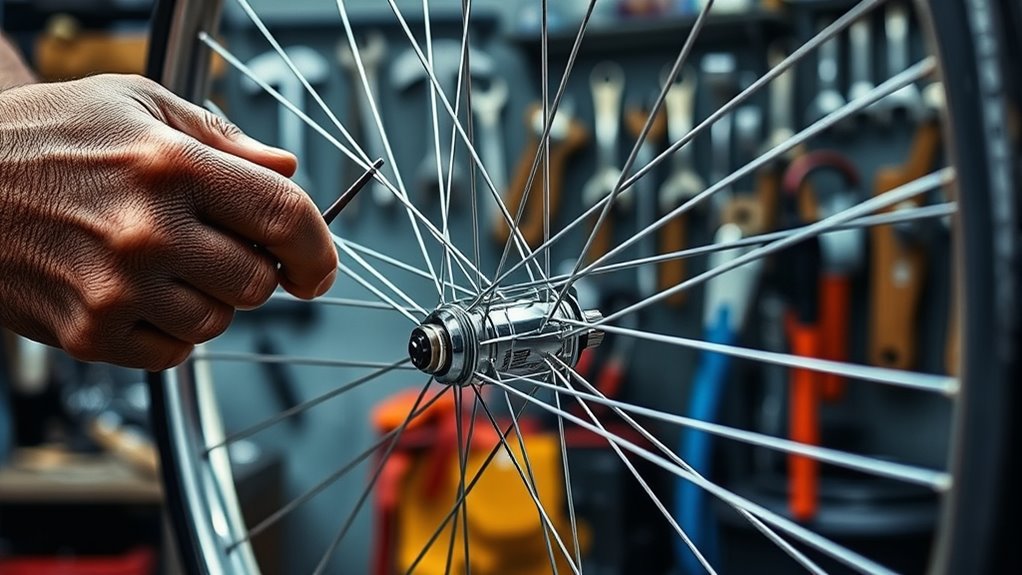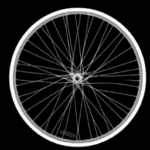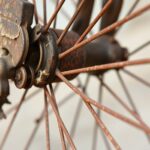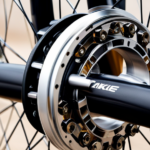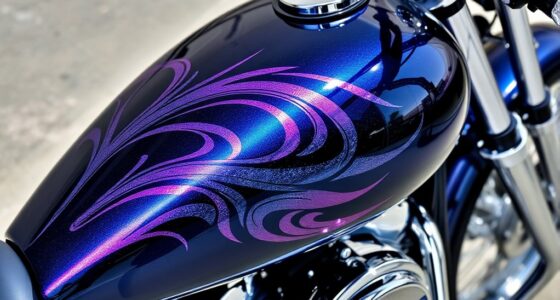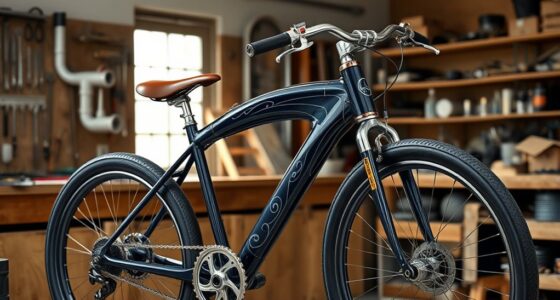To build a wheel, start by choosing compatible components like rims, hubs, spokes, and nipples. Make certain the rim is drilled accurately to match your hub’s spoke pattern, as proper drilling prevents imbalance and wobbling. Tension your spokes evenly to keep the wheel true and strong under load. Attention to detail in drilling and tensioning is key to a durable, high-performance wheel. Keeping these basics in mind will help you create a reliable wheel—more tips await if you keep going.
Key Takeaways
- Select compatible components like rim, hub, spokes, and nipples suited for your riding style.
- Ensure proper rim drilling with precise hole alignment to promote even spoke tension.
- Achieve consistent spoke tension using a tension meter or sound test to prevent wheel wobbling.
- Balance spoke tension across the wheel to maintain true alignment and load distribution.
- Focus on meticulous assembly and regular adjustments for a durable, high-performance wheel.

Ever wondered what goes into building a strong, reliable wheel? It’s a combination of precise craftsmanship and understanding how each component works together. The process starts with selecting the right rim, hub, spokes, and nipples, but the real skill lies in how you assemble and tune everything. One of the most vital factors is spoke tension. If the spokes are too loose, your wheel becomes wobbly and weak. Too tight, and you risk damaging the rim or spokes. Achieving the right spoke tension ensures your wheel stays true under load and resists deforming over time. You’ll need a tension meter or a good ear for sound to feel the right tension, balancing each spoke so they’re evenly tensioned. Proper tensioning also prevents spokes from going slack or snapping under stress, which can lead to wheel failure. Developing a good sense of self-awareness can help you identify when your wheel needs adjustment and improve your overall craftsmanship.
Another key aspect is rim drilling. Before you even lace the spokes, the rim must be drilled correctly. Rim drilling involves creating precise holes in the rim for the spokes to pass through. These holes need to be aligned perfectly to match the spoke pattern and hub flange. If the holes are misaligned or uneven, it can cause uneven spoke tension and wheel imbalance. Proper rim drilling ensures that each spoke is positioned correctly, promoting even load distribution across the wheel. This step is essential because it affects how smoothly and durably your wheel will spin. When you drill the rim, you should use the right tools and follow a consistent pattern that matches your spoke count and lacing pattern. Many rims come pre-drilled, but if you’re customizing or building a wheel from scratch, paying close attention to rim drilling is fundamental for achieving a balanced, durable wheel.
In essence, building a wheel involves careful attention to detail, especially regarding spoke tension and rim drilling. These elements are interconnected; precise rim drilling allows for even spoke tensioning, which is necessary for a wheel that’s both strong and true. As you progress in wheelbuilding, you’ll find that measuring and adjusting spoke tension becomes second nature, and understanding rim drilling helps you troubleshoot issues early. By focusing on these fundamentals, you ensure that your wheel can handle the demands of riding, whether you’re commuting, racing, or tackling rough trails. It’s a meticulous process, but the stability and performance of a well-built wheel make every effort worth it.
Frequently Asked Questions
What Tools Are Essential for Beginner Wheelbuilding?
You need essential tools like a spoke wrench, truing stand, and nipple driver for beginner wheelbuilding. These tools help you guarantee proper spoke tension and maintain correct spoke patterns for wheel strength. Check rim compatibility to avoid issues with fit and performance. With these tools, you can accurately build and true your wheels, gaining confidence as you learn the process and create durable, well-constructed wheels tailored to your riding needs.
How Do I Choose the Right Spokes for My Bike?
Choosing the right spokes is like picking the right brush for a masterpiece—you need the correct spoke gauge and pattern. For a sturdy ride, go for a 14 or 15-gauge spoke, depending on your weight and riding style. Consider your spoke pattern—radial or cross—that best suits your bike’s purpose. You want spokes that balance strength and weight, ensuring your wheel is reliable and smooth, just like a well-painted picture.
What Common Mistakes Should I Avoid When Building a Wheel?
When building a wheel, avoid uneven spoke tension, which can cause wheel wobble or failure. Make sure to check rim alignment frequently, as misaligned rims lead to poor handling and uneven wear. Don’t over-tighten spokes, as this weakens the wheel, or leave tension too loose, risking spoke breakage. Always double-check your work, ensuring consistent tension and true rim alignment for a strong, durable wheel.
How Can I Tell if a Wheel Is Properly Tensioned?
Your wheel’s tension is perfectly spot-on when it’s as tight as a drum and stays true under pressure. Check spoke tension with a tension meter or by plucking spokes—listen for a consistent pitch. Spin the wheel to see if it wobbles; if it’s true, it won’t wobble side to side. Proper tension guarantees your wheel stays true and strong, making your ride smooth and reliable.
What Maintenance Is Needed to Keep Wheels True?
To keep your wheels true, regularly inspect the rim for dents or cracks and check spoke tension. Lubricate spokes to prevent corrosion and guarantee smooth adjustments. If you notice wobbling or uneven spoke tension, tighten or loosen spokes as needed, maintaining even tension across the wheel. Consistent rim inspection and spoke lubrication help prevent issues, preserving wheel integrity and ensuring safe, smooth rides.
Conclusion
Now that you’ve learned the basics, you’re practically a wheelbuilding expert—ready to tackle any rim and spoke combo. Ironically, after all this talk of tension and truing, the real challenge might be just convincing yourself it’s okay to get a little creative with those spokes. But don’t worry, with patience and practice, you’ll be turning heads—and wheels—in no time. Who knew building a wheel could be so rewarding, yet so unexpectedly fun?
